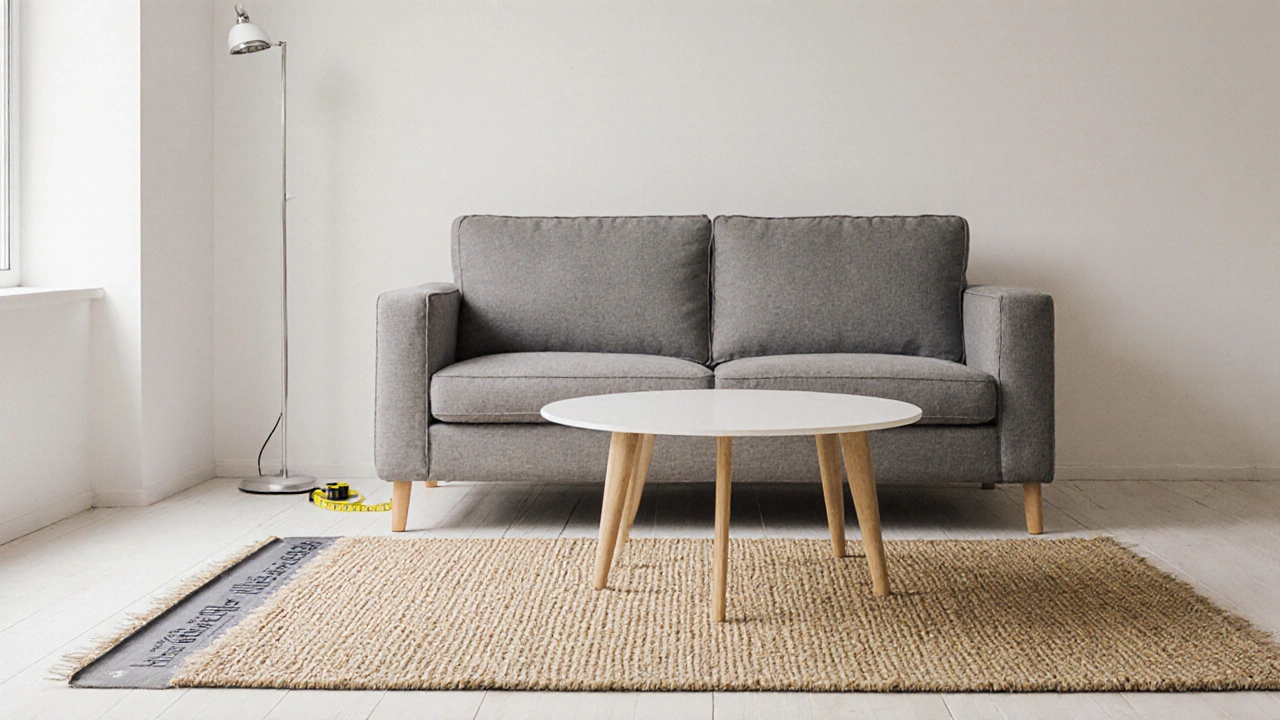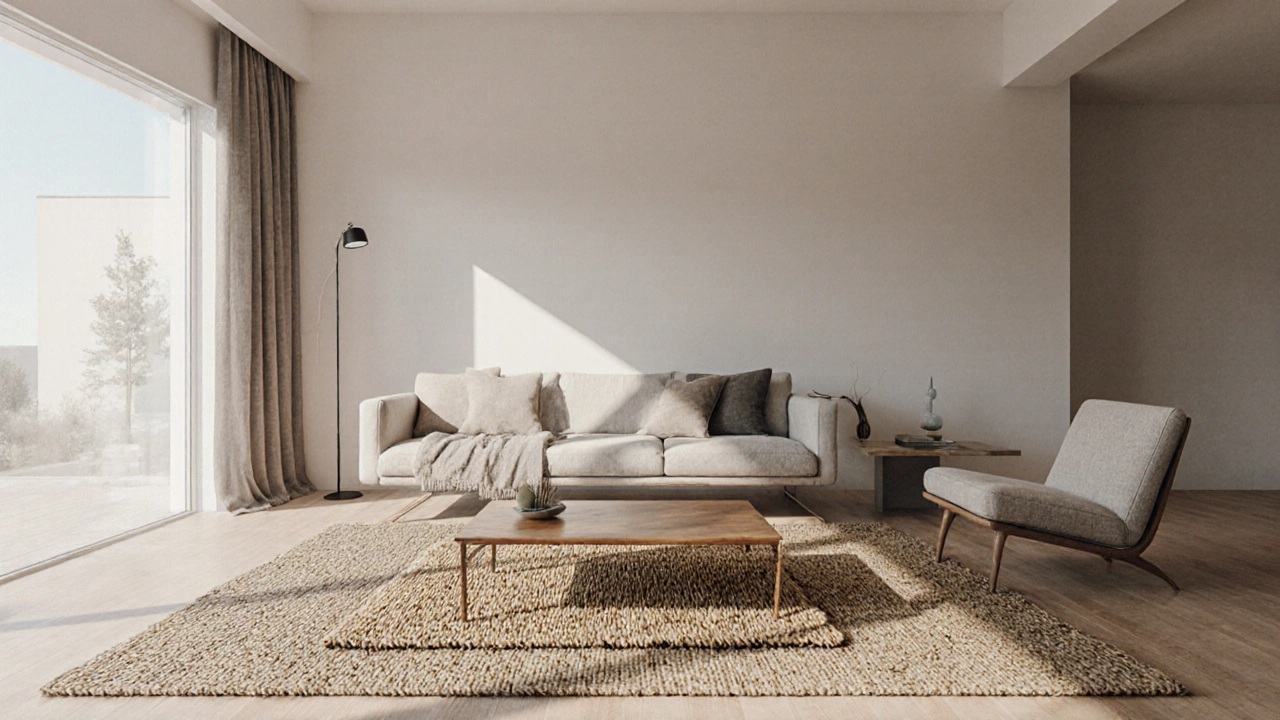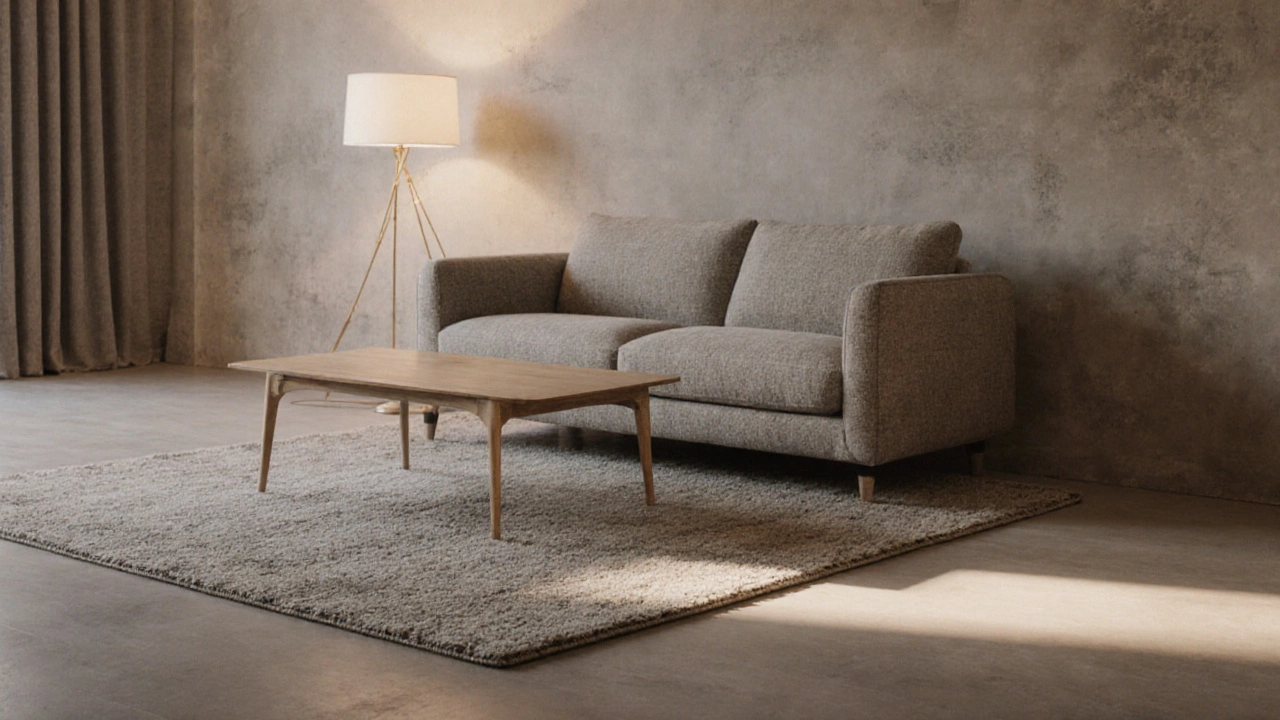Rug Size Calculator
Find Your Perfect Rug Size
Calculate the ideal rug size for your coffee table based on the article's guidelines. The rug should be large enough to fit the front legs of your sofa and all four legs of your coffee table.
Enter your furniture dimensions to get the ideal rug size recommendation.
Ever walk into a living room and feel like something’s off? The coffee table sits there like an island. The sofa looks right, the TV’s at eye level, but the whole space feels disconnected. More often than not, the missing piece isn’t a lamp or a plant-it’s a rug under the coffee table.
Why a rug under a coffee table works
A rug under a coffee table isn’t just decoration. It’s the foundation of your living room’s layout. Think of it like the frame around a painting. Without it, the furniture floats. With it, everything anchors together.Most people think rugs are for warmth or comfort underfoot. That’s true, but the real power of a rug is how it defines space. In an open-plan home, a rug tells your eyes where the seating area begins and ends. A coffee table sitting on a rug stops looking like it wandered in from another room. It belongs.
Studies from the University of Cambridge’s Interior Design Lab show that rooms with area rugs under central furniture pieces are perceived as 37% more cohesive by viewers. That’s not magic-it’s psychology. Our brains crave order. A rug creates visual boundaries without walls.
How big should the rug be?
Size matters more than you think. Too small, and your coffee table looks like it’s standing on a tiny island. Too big, and it overwhelms the space.The rule most interior designers use: the rug should be large enough so that the front legs of your sofa and all four legs of your coffee table sit on it. If you have a large sectional, at least the front two legs of each piece should be on the rug. This creates a grounded, balanced look.
For a standard 3-seater sofa and a 48-inch coffee table, aim for a 9x12 rug. If your space is smaller-say, a studio or apartment living area-a 6x9 works. Avoid 5x8 rugs unless your furniture is very compact. A rug that’s too small makes the room feel cramped.
Here’s a quick check: stand at your sofa and look toward the coffee table. If you can see bare floor between the rug edge and the sofa legs, the rug’s too small. You want the rug to feel like it’s holding everything together, not just sitting under one piece.
What shape and style works best?
Shape should match your furniture. If your coffee table is rectangular, go with a rectangular or square rug. It creates symmetry. If your table is round or oval, a round or oval rug helps soften the lines and makes the space feel more inviting.Pattern? That’s personal. But here’s the trick: if your sofa or armchairs are solid colors, a patterned rug adds life. If your furniture already has bold prints or textures, go neutral. A busy rug on top of a busy sofa fights for attention. Your eyes don’t know where to land.
Material matters too. Wool rugs hold up better under heavy furniture and foot traffic. Cotton or synthetic blends are easier to clean but don’t last as long. If you have kids or pets, go for a low-pile rug. High-pile shags look nice but trap dirt and make it harder to slide the coffee table around.
What if your coffee table is too big for the rug?
This happens more than you’d think. You buy a gorgeous oversized coffee table-maybe 60 inches long-and realize your rug only fits 48 inches. Don’t panic.You have two real options:
- Go bigger. Upgrade to a rug that lets the front legs of your sofa and all legs of the table sit on it. This is the ideal fix.
- Let the table hang off. If you can’t change the rug, let the coffee table sit partially on the rug. Just make sure the front legs are on it. The back legs can be on the floor. It’s not perfect, but it’s acceptable if the rug is large enough to anchor the seating area.
Avoid the middle ground: a rug that’s just big enough for the table but leaves the sofa completely off. That looks accidental, not intentional.

Do you need a rug pad?
Yes. And not because you want to stop slipping. A rug pad protects your floor, reduces noise, and keeps the rug from bunching up when you move the coffee table.Hardwood floors? A rug pad prevents scratches from table legs. Tile? It stops the rug from sliding around. Carpet? A thin pad helps the rug lie flat and adds cushion.
Look for a non-slip, felt-backed pad that’s the same size as your rug or slightly smaller. Don’t use rubber-backed pads-they can stain hardwood over time. A good pad costs $20-$40 but saves you hundreds in floor repairs later.
What about layered rugs?
Layering rugs is trending, but it’s not for everyone. If you want to try it, place a smaller, textured rug (like a jute or sisal) under your main rug. The main rug goes on top, centered under the coffee table.This adds depth and warmth. But here’s the catch: only do this if your main rug is large enough to still meet the front-leg rule. A layered rug shouldn’t make the rug under the table feel smaller. If the bottom rug peeks out too much, it looks messy, not stylish.
Best for: large living rooms with high ceilings. Worst for: small spaces or rooms with low lighting. Too many layers in a tight space make it feel cluttered.
When you shouldn’t put a rug under your coffee table
There are exceptions. Not every room needs a rug under the coffee table.First, if your floor is already a statement-like wide-plank oak with a rich stain or polished concrete-sometimes the floor itself is the design. Adding a rug can mute that. In those cases, skip the rug and let the floor shine.
Second, if your coffee table is very tall or unusually shaped-like a pedestal base or a sculptural piece-it might look better floating. This is common in modern or minimalist interiors. The goal is clean lines. A rug might break that.
Third, if you live in a humid climate and your floor is prone to moisture (like a basement or ground-floor flat), a rug can trap dampness. In those cases, go with a hard surface or a waterproof indoor-outdoor rug.

Real-life examples
In a Birmingham terraced house I helped style last year, the client had a small living room with a 42-inch round coffee table and a two-seater sofa. They were using a 5x7 rug, but the table sat right on the edge. The room felt disjointed. We switched to a 6x9 wool rug. The front legs of the sofa and all four legs of the table now sat on it. The room instantly felt larger, calmer, and more put-together.Another client, a young couple in a new build with an open-plan kitchen-living area, used a large 8x10 jute rug under their low, rectangular coffee table. They didn’t want color or pattern-they wanted texture and warmth. The rug tied the seating area together without competing with their gray sofa and white walls.
Both cases had different styles, different rugs, but the same principle: anchor the coffee table. That’s the goal.
Final checklist
Before you buy or rearrange:- Is your rug large enough to fit the front legs of your sofa and all legs of your coffee table?
- Does the rug’s shape match your furniture? (Rectangular table? Rectangular rug.)
- Is the material durable enough for your lifestyle? (Pets? Kids? High traffic?)
- Do you have a rug pad underneath?
- Does the rug complement your sofa’s color and pattern-or at least not fight it?
If you answered yes to all five, you’ve nailed it. If not, tweak one thing. Maybe swap the rug size. Maybe add a pad. Maybe change the pattern. Small changes make big differences.
What’s the worst that can happen?
Nothing, really. A rug under a coffee table isn’t a rule-it’s a tool. If you love the look of bare floor and your coffee table sits beautifully on its own, go for it. But if your room feels off, if your furniture looks scattered, if your space lacks that ‘homey’ feel-try the rug. It’s one of the cheapest, easiest ways to transform your living room.Start with the size. Get it right, and everything else falls into place.
Do you need a rug under a coffee table?
No, you don’t absolutely need one-but most living rooms look better with it. A rug under the coffee table ties the seating area together, makes the space feel grounded, and adds warmth. If your furniture looks like it’s floating or the room feels disconnected, a rug is the fix.
How big should a rug be under a coffee table?
The rug should be large enough so that the front legs of your sofa and all four legs of your coffee table sit on it. For a standard 3-seater sofa and 48-inch coffee table, a 9x12 rug works best. In smaller rooms, a 6x9 is enough. Avoid rugs smaller than 5x8 unless your furniture is very compact.
Can you put a rug under a glass coffee table?
Yes, and it’s actually a great idea. Glass tables can look cold or floating without a rug. A rug adds warmth and defines the seating area. Make sure the rug is large enough to anchor the sofa too. A non-slip pad is essential with glass tables to prevent sliding.
Should the coffee table be centered on the rug?
Yes, it should be centered. The rug is the foundation, and the coffee table should sit as the focal point on top of it. If the table is off-center, the whole layout looks unbalanced. Use a tape measure to align it properly.
Can you use a round rug with a rectangular coffee table?
You can, but it’s not ideal. A round rug under a rectangular table creates visual tension. It works only if you’re going for a deliberate, modern contrast. For most homes, matching shapes-rectangular table with rectangular rug-feels more natural and cohesive.
Is it okay to have a rug that doesn’t go under the sofa?
Only if the rug is very small and meant as an accent. For a proper living room layout, the rug should extend under the front legs of the sofa. If the sofa is completely off the rug, the seating area looks disconnected from the coffee table. That breaks the visual flow.


Write a comment